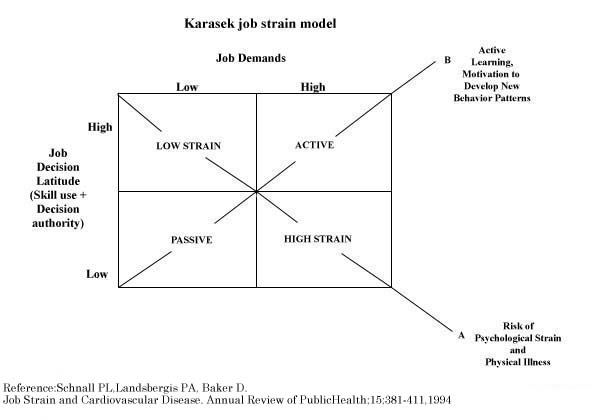A Brief Introduction to Job Strain
Peter Schnall M.D., M.P.H.
Research conducted since the end of WWII into the causes of hypertension and coronary heart disease has identified a number of important risk factors that contribute to the development of these illnesses such as excessive caloric and fat intake leading to obesity and elevated blood cholesterol, cigarette smoking, high blood pressure, and diabetes, all of which contribute to atherosclerosis. Unfortunately, the cause(s) of high blood pressure have proven more difficult to identify, though being overweight has long been recognized as a risk factor for hypertension. Recently, attention has focused on the workplace as a potential source of stressors that might contribute to the development of hypertension.
A number of specific stressful working conditions, such as repetitive work, assembly-line work, electronic monitoring or surveillance, involuntary overtime, piece-rate work, inflexible hours, arbitrary supervision, and deskilled work, have been studied. Over the last 15 years, a new model of job stress (see figure) developed by Robert Karasek has highlighted two key elements of these stressors, and has been supported by a growing body of evidence. Karasek’s “job strain” model states that the greatest risk to physical and mental health from stress occurs to workers facing high psychological workload demands or pressures combined with low control or decision latitude in meeting those demands. Job demands are defined by questions such as “working very fast,” “working very hard,” and not “enough time to get the job done.” Job decision latitude is defined as both the ability to use skills on the job and the decision-making authority available to the worker. In some recent studies, this model was expanded to include a third factor – the beneficial effects of workplace social support. While there are a variety of models of “job stress,” the “job strain” model emphasizes the inter-action between demands and control in causing stress, and objective constraints on action in the work environment, rather than individual perceptions or “person-environment fit.” Karasek’s model emphasizes another major negative consequence of work organization;: how the assembly­line and the principles of Taylorism, with its focus on reducing workers’ skills and influence, can produce passivity, learned helplessness, and lack of participation (at work, and in the community, and in politics). The “job strain” model (see figure) has two components – increasing risk of heart disease following arrow A, but increasing activity, participation, self- esteem, motivation to learn, and sense of accomplishment following arrow B. Thus, this model provides a justification and a public health foundation for efforts to achieve greater worker autonomy as well as increased workplace democracy.
Considerable evidence exists linking “‘job strain’” to hypertension and coronary heart disease. Over the last decade more than 40 studies on “job strain” and heart disease and 20 studies on “job strain” and heart disease risk factors have been published throughout the world providing strong evidence that “job strain” is a risk factor for heart disease1. Of the eight studies where an ambulatory (portable) blood pressure monitor was worn during a work day, five showed strong positive associations between “job strain” and blood pressure, while three others provided mixed results. Since Because ambulatory blood pressure is both more reliable (since there is no observer bias and the number of readings is greatly increased) and more valid (since blood pressure is measured during a person’s normal daily activities including work) than casual measures of blood pressure, we feel confident in placing more emphasis on the ambulatory blood pressure results.
The issue of job stress is of utmost importance to the public health community and working people. The economic costs of job stress in general (absenteeism, lost productivity) are difficult to estimate but could be as high as several hundred -billion dollars/ per year (2, p. 167-8). Most importantly, there is the potential for preventing much illness and death. More than 50 million Americans have high blood pressure, and, in 95% percent of cases, the cause is unknown. While estimates of the proportion of heart disease possibly due to “job strain” vary greatly between studies, Karasek and Theorell (5, p. 167) calculate that up to 23% percent of heart disease could potentially be prevented (over 150,000 deaths prevented per year in the U.S.) if we reduced the level of “job strain” in jobs with the worst strain levels to the average of other occupations.
1 Schnall PL, Landsbergis PA, Baker D. Job Strain and Cardiovascular Disease. Annual Review of Public Health; 15:381-411,1994.Schnall PL, Landsbergis PA, Schwartz JE, Pickering TG. Job Strain and Hypertension.
2 Karasek RA, Theorell T. 1990. Healthy Work. New York: Basic Books


